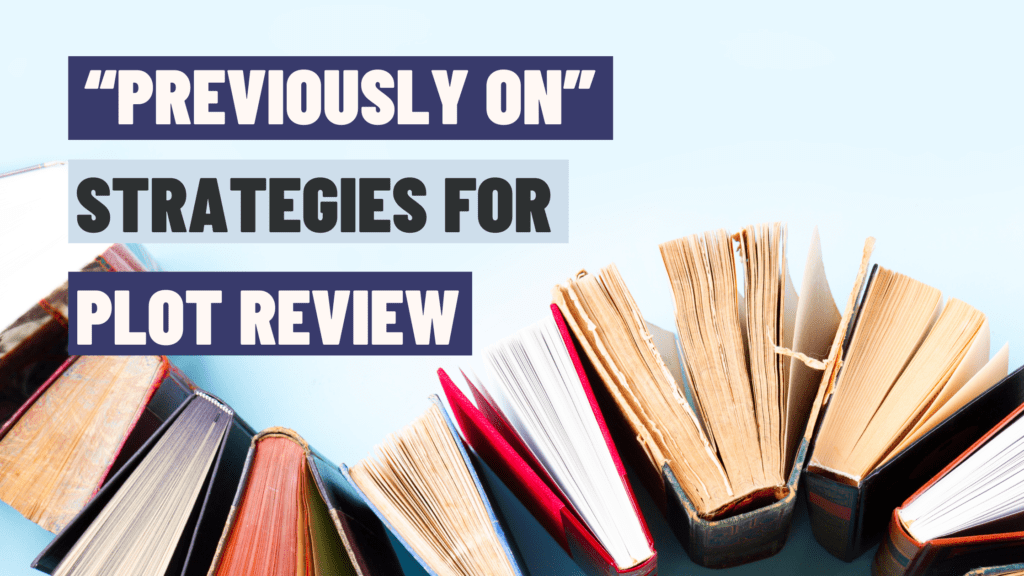The “Previously On…” plot review is a powerful tool borrowed from the world of television series. In the English classroom, this strategy serves multiple purposes: it refreshes students’ memories, connects past learning to new content, and immediately engages students in literary discussion. Let’s explore how to implement this technique effectively in your English lessons.

Table of Contents
The Psychology Behind the Recap
Recaps work by activating prior knowledge, a crucial step in the learning process. They also:
- Create a sense of continuity in learning
- Help students identify key information
- Build anticipation for new content
- Reinforce important concepts through repetition

Implementing the “Previously On…” Recap
1. The Classic Verbal Plot Review
How it works: You, as the teacher, provide a brief, engaging summary of previous material as a plot review.
Example:
“Previously in our journey through ‘1984’… Winston began keeping a forbidden diary, encountered Julia passing him a secret note, and started questioning the Party’s control over history. Today, we’ll explore how these acts of rebellion escalate as Winston enters the mysterious antique shop.”
Tips for success:
- Use dramatic pauses and inflection to build suspense (my style is to make them OVERdramatic so that this is over the top and kind of silly)
- Highlight key plot points, character developments, and themes
- End with a teaser for the day’s lesson

2. Student-Led Recaps
How it works: Students take turns leading the recap session.
Example:
Assign a “Recap Captain” for each class. They prepare a 2-minute summary of the previous lesson, including key quotes and discussion points.
Tips for success:
- Provide a recap template to guide students
- Encourage creativity in presentation (e.g., newscaster style, gossip column format)
- Allow peer feedback to refine recap skills
3. The Collaborative Story Chain
How it works: Each student contributes one sentence to collectively recap the previous lesson or reading.
Example:
Start with “Last time, we learned that Gatsby…” and have each student add a detail, moving through plot points, character insights, and thematic elements.
Tips for success:
- Use a prop (like a talking stick…or something like a squishy ball that they can toss to one another) to manage turns
- Encourage students to connect their sentence to the previous one
- Gently guide the recap if it strays off course

4. The Quote Quest for Plot Review
How it works: Display key quotes from the previous lesson or reading. Students explain their significance and context.
Example:
Project quotes like “Gatsby believed in the green light, the orgastic future that year by year recedes before us.” Have students discuss its meaning and importance to the story.
Tips for success:
- Choose quotes that highlight important themes or character development
- Ask students to connect quotes to broader literary concepts
- Use this as a springboard to introduce related quotes from the day’s reading
5. Plot Review Roulette
How it works: Create a spinner (physical or digital) with different recap prompts. Spin to randomly select the day’s recap method.
Example:
Prompts could include “Summarize in a tweet,” “Create a six-word story,” “Draw a quick sketch,” or “Explain to an alien.”
Tips for success:
- Include a mix of verbal, written, and visual plot review methods
- Allow students to spin the wheel for added engagement
- Use this method sparingly to maintain its novelty
6. AI-Generated Recap Songs
How it works: Use AI tools to create catchy, summary songs of the previous lesson or reading assignment to serve as plot review.
Example:
Generate a short song that recaps key events from The Great Gatsby chapter you discussed in the previous class. The song could be in the style of 1920s jazz or a modern pop song, depending on your preference and what resonates with your students.
Tips for success:
- Use AI tools that allow you to specify the musical style, key points to include, and desired length
- Play the song as students enter the classroom to set the tone
- Provide lyrics and encourage students to sing along
- Discuss the accuracy and completeness of the AI-generated recap, promoting critical thinking
Benefits:
- Makes recaps more memorable through music and rhythm
- Introduces an element of fun and surprise
- Opens discussions about AI in creative processes
Potential AI tools to use:
- ChatGPT or similar language models for lyrics generation
- AI music generation tools like AIVA, Amper Music, or Mubert (I really like Suno!)
- Text-to-speech tools with musical backgrounds for a complete package
Extension activities:
- Have students collaborate with AI to create their own recap songs
- Analyze the AI-generated lyrics as a way to discuss summarization skills
- Compare AI-generated recaps with student-created ones to discuss the strengths and limitations of AI in understanding literature

Adapting Recaps for Different English Topics
Literature Study
- Focus on plot progression, character development, and emerging themes
- Highlight literary devices encountered and their effects
Writing Instruction
- Recap key elements of the writing style or format being studied
- Review common errors or challenges from previous writing sessions
Grammar Lessons
- Quickly review previously learned rules and their applications
- Use example sentences that incorporate both old and new concepts
Vocabulary Development
- Start with a rapid-fire review of recently learned words
- Challenge students to use recap time to incorporate new vocabulary
Overcoming Challenges
Challenge: Students haven’t completed the reading
Solution: Use the recap to provide crucial information without spoiling key plot points. This can motivate students to catch up.
Challenge: Varying levels of comprehension
Solution: Use collaborative recap methods that allow stronger students to support those who are struggling.
Challenge: Time constraints
Solution: Set a strict time limit (e.g., 5 minutes) and use a visible timer to keep the recap focused and efficient.
Challenge: Monotony
Solution: Vary your recap methods and incorporate elements of surprise or gamification to keep students engaged.
Conclusion
The “Previously On…” recap, when used creatively and consistently, can transform the opening minutes of your English class into an effective plot review session. It bridges lessons, reinforces learning, and sets an engaging tone for literary exploration.
How do you use recaps in your English class? Comment with your own innovative “Previously On…” techniques!
